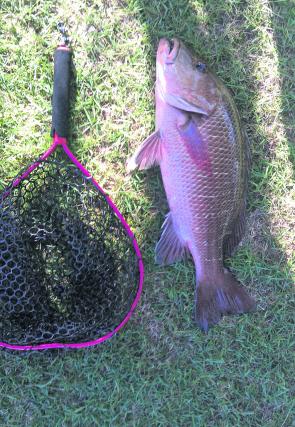It is the end of those cold winter months, and things are starting to warm up again.
The fishing over this past winter has been steady, with good-sized tailor, jewfish and various species of trevally on the chew. Whiting, flathead and bream have also been prevalent around the main stretches, attracting many anglers of all ages.
Even though there will be many species throughout the river on offer, the main focus for anglers at this time of year are the big whiting and mangrove jack! Even though jacks have been being caught every now and then throughout the end of winter, they should start to show up frequently as they love the warm water.
This is the same for summer whiting, the cousins of the smaller winter whiting. Anglers of all fishing styles will be chasing these great species of fish, using many different methods and tactics.
Over the last few years, whiting have become a lot more common in the lure fishing world. Even though they are commonly targeting on various baits, lure fishing for this species is great.
When locating whiting, look for shallow sand flats with small weed edges throughout the river, especially around the frying pan at the mouth of the river. This is where the whiting will be foraging for small crustaceans in among the sand.
If you prefer bait fishing, there are many options to choose from. Peeled prawns, live yabbies (self-caught) and live sandworms work the treat. When using baits, light 4-6lb monofilament line is ideal for chasing whiting. Rig these baits onto a small ball sinker, barrel swivel, a 40-50cm trace, and to finish it off use a small long shank hook.
When using bait, whiting have a very distinct bite, almost like a small ‘bump-bump-bump’. Remember not to strike too hard as this will easily pull the hook, and spook the fish.
If you want to get a bit more serious and lure fish for them, then there are many things to consider. To start off, a lightweight 1-2kg rod, and a 1000-1500 size reel are ideal for these particular fish, but a little heavier won’t hurt. Braided fishing line is really effective to use on any kind of lure fishing, as it allows a longer casting distance (when using small lures for whiting) and is a lot more sensitive than regular mono line. If 2-4lb braid is used, rigged on the above recommended set up, then you will be set!
When using soft plastics on these fish, small prawn or sandworm imitations work great. Squidgies Wrigglers (small) are a favourite, weighted on a light jighead.
If looking at using hardbodies for these fish, use a small, clear coloured surface lure, either a popper or surface walker. Cast across sand flats where you think whiting may be, and use a quick twitch action with a few pauses.
Whiting will attack these lures, and also various baits, with aggression and put up a great fight!
The mighty mangrove jack will start to show up in good numbers as the weather becomes warmer. These fish fight aggressively and won’t give in easy. If you think you are ready to start tackling these feisty jacks, then a bit of know-how is needed.
Strong main line and a heavy leader are recommended to keep these fish from busting you off on the snags. They will hit in an instant, and swim right back into their lair, sometimes snapping the leader before you have a chance to strike. This is why focus is needed when targeting these fish.
You will need a strong rod that is able to take in a lot of pulling power with a good quality reel containing a good drag system. This can be rigged with 20lb main line and a heavier 30lb leader, since jacks do have a big set of teeth!
If bait fishing, strips of mullet and live baitfish (herring or mullet) are on the top of the list for jack. Drifting these baits into a good looking snag where a jack might be holding is a good tactic. Always make sure that an unsecured rod is not left unattended, it just might be the last time you see it!
Lure fishing for jack is another story – these fish have a knack of stealing lures. They are really powerful on the strike; so the drag must be set just enough so you have some pulling power to get the jack out of the snag, but just enough so that there is not too much strain on the main line.
Keen lure anglers will prefer to fish lures on a lighter set up, averaging around 8-10lb main line and a 12-15lb leader. But this can sometimes be frustrating as lighter lines and leaders can result in an easy bust off.
Good lures to use are larger sized soft plastics, including prawn imitations and various deep divers, that ‘bang’ on the snags attracting the jack’s attention.
When looking for a good area for jacks, snaggy areas, rock bars, bridge pylons and large fallen logs and trees are where they like to sit and wait in ambush. It is key to land your lure or bait as close as you can to a snag, for the best opportunity to hook up.
Mangrove jack will be caught all throughout the river, but in the past the areas between the lakes (Lake Cooroibah and Cootharaba), have been the best producing.
If you’re keen to get down on the water this month then try your skills in the Noosa River system. It should start to produce well with these species of fish.
Remember to mix it up sometimes to find out what’s working the best, these tactics will not let you down!
Reads: 3667
Mangrove jack will start to show up in good numbers as the weather becomes warmer.




